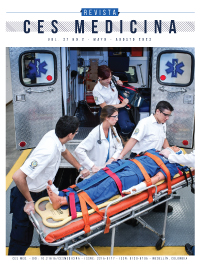Traumatic pneumomediastinum following Macklin effect. Case report
DOI:
https://doi.org/10.21615/cesmedicina.6768Keywords:
pneumomediastinum, Macklin effect, chest pain, wounds and injuriesAbstract
Introduction: pneumomediastinum is defined as the presence of free air around mediastinal structures. It is a rare and alarming radiological finding in the context of polytraumatized patients and its adequate study allows the prevention of potentially lethal injuries. Methods: the case of a 43-year-old male patient admitted in the context of blunt polytrauma is presented. On physical examination, he was found to have subcutaneous emphysema and borderline saturation, with a tomographic finding of pneumomediastinum. Results: esophagogastroduodenoscopy was performed, which was reported as normal and there was no increase in subcutaneous emphysema during follow-up, classifying the case as secondary to the Macklin effect. Subsequently, the patient was discharged in adequate conditions and without repercussions during his hospital stay. Conclusions: pneumomediastinum is a rare but alarming entity that requires knowledge of its causes and study of them in order to prevent potentially lethal lesions.
Downloads
References
Matthees NG, Mankin JA, Trahan AM, Israr S, Jones MD, Dameworth JL, et al. Pneumomediastinum in blunt trauma: If aerodigestive injury is not seen on CT, invasive workup is not indicated. Am J Surg. 2019;217(6):1047-50. https://doi.org/10.1016/j.amjsurg.2018.11.002
Dissanaike S, Shalhub S, Jurkovich GJ. The Evaluation of Pneumomediastinum in Blunt Trauma Patients: J Trauma Inj Infect Crit Care. 2008;65(6):1340-5. https://doi.org/10.1097/ta.0b013e318169cd24
Wintermark M, Schnyder P. The Macklin Effect: A Frequent Etiology for Pneumomediastinum in Severe Blunt Chest Trauma. Chest. 2001;120(2):543–7. https://doi.org/10.1378/chest.120.2.543
Assenza M, Passafiume F. Pneumomediastinum and Pneumoperitoneum after Blunt Chest Trauma:The Macklin Effect. J Trauma Treat. 2012;01(01). https://www.omicsonline.org/open-access/pneumomediastinum-and-pneumoperitoneum-after-blunt-chest-trauma-the-macklin-effect-2167-1222.1000107.pdf
Molena D, Burr N, Zucchiatti A, Lovria E, Gestring ML, Cheng JD, et al. The incidence and clinical significance of pneumomediastinum found on computed tomography scan in blunt trauma patients. Am Surg. 2009;75(11):1081-3.
Carzolio-Trujillo HA, Navarro-Tovar F, Padilla-Gómez CI, Hernández-Martínez IA, Herrera-Enríquez J. Blunt chest trauma with pneumomediastinum and pneumoperitoneum secondary to Macklin effect. Case report. Cir Cir Engl Ed. 2016;84(5):409-14. https://www.elsevier.es/es-revista-cirugia-cirujanos-english-edition--237-articulo-blunt-chest-trauma-with-pneumomediastinum-S2444050716300614
Bejvan SM, Godwin JD. Pneumomediastinum: old signs and new signs. Am J Roentgenol. 1996;166(5):1041-8. https://doi.org/10.2214/ajr.166.5.8615238
Rezende-Neto JB, Hoffmann J, Al Mahroos M, Tien H, Hsee LC, Spencer Netto F, et al. Occult pneumomediastinum in blunt chest trauma: Clinical significance. Injury. 2010;41(1):40-3. https://doi.org/10.1016/j.injury.2009.06.161
Chouliaras K, Bench E, Talving P, et al. Pneumomediastinum Following Blunt Trauma: Worth an Exhaustive Workup? J Emerg Med. 2016];50(1):210. https://doi.org/10.1016/j.jemermed.2015.11.023
Martín-Menjívar E, Vázquez MJC, Ferrero BE et al. Efecto Macklin como causa de neumomediastino posterior a contusión torácica. Reporte de un caso. Trauma. 2007;10(2):58–61. https://www.medigraphic.com/pdfs/trauma/tm-2007/tm072f.pdf
Murayama S, Gibo S. Spontaneous pneumomediastinum and Macklin effect: Overview and appearance on computed tomography. World J Radiol. 2014 28;6(11):850–4. https://doi.org/10.4329/wjr.v6.i11.850
Mansella G, Bingisser R, Nickel CH. Pneumomediastinum in Blunt Chest Trauma: A Case Report and Review of the Literature. Case Rep Emerg Med [Internet]. 2014:1-6. https://doi.org/10.1155/2014/685381
Zachariah S, Gharahbaghian L, Perera P, Joshi N. Spontaneous Pneumomediastinum on Bedside Ultrasound: Case Report and Review of the Literature. West J Emerg Med. 2015;16(2):321-4. https://doi.org/10.5811/westjem.2015.1.24514
Estrada MC, Velásquez MI, Orrego M. Neumomediastino espontáneo: reporte de un caso y revisión de la literatura. CES Med. 2010;23(2):47-53. https://revistas.ces.edu.co/index.php/medicina/article/view/907
Kunisch-Hoppe M, Hoppe M, Rauber K, Popella C, Rau WS. Tracheal rupture caused by blunt chest trauma: radiological and clinical features. Eur Radiol. 2000;10(3):480-3. https://doi.org/10.1007/s003300050080
Downloads
Published
How to Cite
Issue
Section
License
Copyright (c) 2023 CES Medicina

This work is licensed under a Creative Commons Attribution-NonCommercial-ShareAlike 4.0 International License.
Derechos de reproducción (copyright)
Cada manuscrito se acompañará de una declaración en la que se especifique que los materiales son inéditos, que no han sido publicados anteriormente en formato impreso o electrónico y que no se presentarán a ningún otro medio antes de conocer la decisión de la revista. En todo caso, cualquier publicación anterior, sea en forma impresa o electrónica, deberá darse a conocer a la redacción por escrito.
Plagios, duplicaciones totales o parciales, traduccones del original a otro idioma son de responsabilidad exclusiva de los autores el envío.
Los autores adjuntarán una declaración firmada indicando que, si el manuscrito se acepta para su publicación, los derechos de reproducción son propiedad exclusiva de la Revista CES Medicina.
Se solicita a los autores que proporcionen la información completa acerca de cualquier beca o subvención recibida de una entidad comercial u otro grupo con intereses privados, u otro organismo, para costear parcial o totalmente el trabajo en que se basa el artículo.
Los autores tienen la responsabilidad de obtener los permisos necesarios para reproducir cualquier material protegido por derechos de reproducción. El manuscrito se acompañará de la carta original que otorgue ese permiso y en ella debe especificarse con exactitud el número del cuadro o figura o el texto exacto que se citará y cómo se usará, así como la referencia bibliográfica completa.
| Article metrics | |
|---|---|
| Abstract views | |
| Galley vies | |
| PDF Views | |
| HTML views | |
| Other views | |



